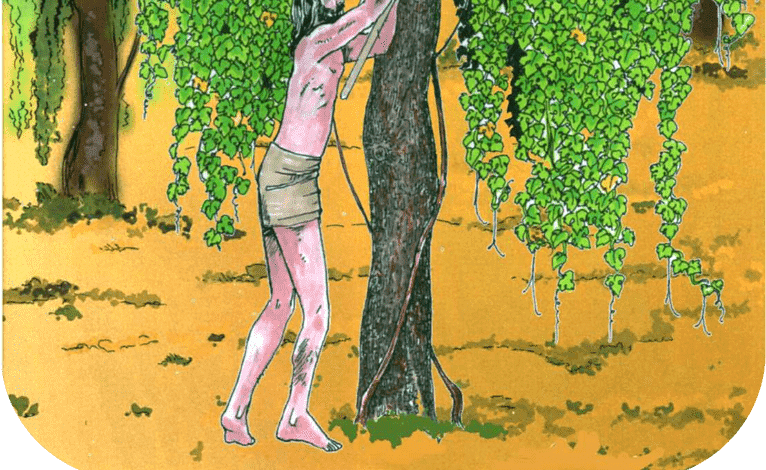
It was a phrase Bart Backaert had dropped during one of our excursions. Did you know that in the old days grapes grew in trees. Elm was especially popular. Why elm he thought aloud. I had to figure that out. Long live the internet. Here comes the beautiful love story of a marriage between the wild grape and a tree.
Meanwhile, this Es is showing off in our gourmet jungle. He calls out loud to marry a grape. If you’re wondering what we’re talking about? Then read on quietly.
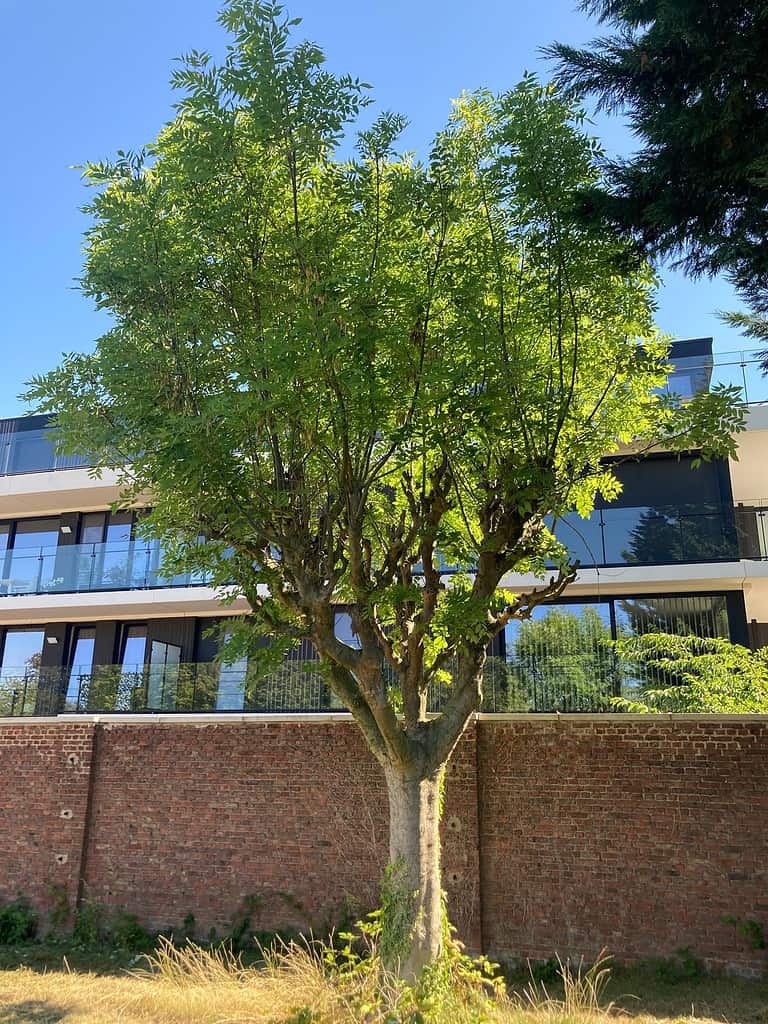
The Etruscans
The Etruscans were the first wine growers in Italy, starting from the wild varieties. The wild vine is a plant native to the Mediterranean region. In ancient times, people began collecting its fruits in the forests.
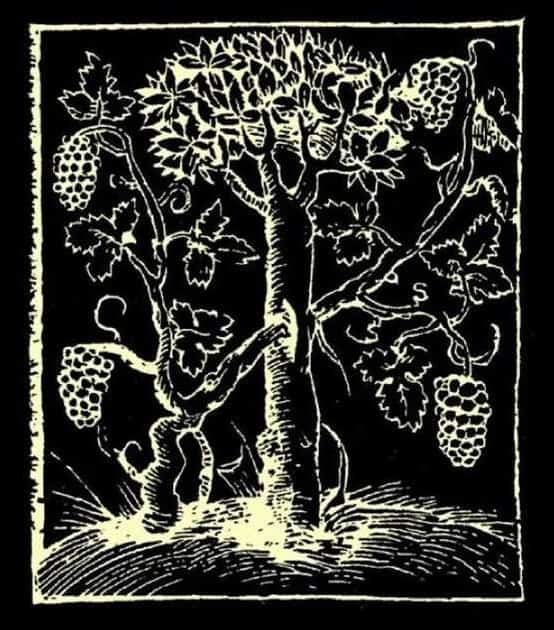
The wild vine (Vitis vinifera sylvestris) is a species native to the Mediterranean region and especially at home in Italy. Even today, it is possible to find wild vines in our forests (although one must pay close attention to distinguish them from feral vines, from old abandoned vineyards). The varieties we grow today are descended from the wild vine, modified over the centuries by selections and crosses performed by man.
Returning to the Etruscans, scholars hypothesize that they have been cultivating the vine since the Bronze Age, but at least since the twelfth century BCE. Chr.
Later, with the development of civilization, as great seafarers and merchants, they had increasingly intense contacts with the peoples of the eastern Mediterranean (especially the Greeks), where culture and viticultural techniques were already more developed. This enabled them to refine production techniques and introduce new tools and new ways of working. New oriental vine varieties were also introduced (whose domestication process had begun in the Caucasus region in a much more distant era). These new vines were also grown and crossed with local varieties.
Thanks to these influences, primitive Etruscan viticulture continued to grow over the centuries and wine production increased in quantity and quality. Thus, from the 6th century b. Chr. also included overseas trade (which we will discuss later).
The Etruscans grew vines in the same way they saw these plants growing wild in the forests. The vine is a climbing shrub, a type of vine. In a forest, its natural habitat in our latitudes, it tends to climb up a tree to reach the light as best it can (it is a very heliophilic species or in other words they need a lot of light). However, it is not a parasite: the vine does not weaken the tree to which it clings.
Today the name of the Etruscan cultivation system is “married vine”, “vite maritata” in Italian. The vine is, as it were, “married” to the tree. This definition is not Etruscan, but originated later, as we shall see. The Etruscan word was “àitason.”

Viticulture in Etruria was not specialized: there was no vineyard, as we understand it today. Instead, the vines were promiscuous with other crops (interspersed with grain fields, olive trees, fruit trees, etc.).
The “married vine” has persisted in Italian wine culture almost to our days, in all those areas where in ancient times the Etruscan civilization had arrived.
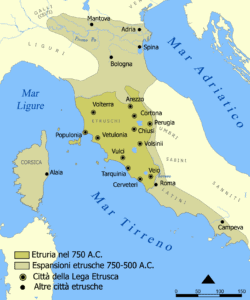
espansione etrusca
In gray-green: Etruria at 750 v. Chr. (Historic Etruria) In gray: conquered territories at 750-500 B.C. Chr.
The Etruscans, from the original area of Tuscany and upper Lazio (called “Historic Etruria”) then widened their borders and expanded into Campania, to the south, and Emilia Romagna to the north. In Campania today there is still the border between the Etruscan wine culture (more to the north) and the Greek (the wine-growing system called “alberello”). In the latter, the vine was grown as a low stalk, without support or with a “dead” support (a pole). The river Sele more or less marked this boundary.
The Etruscans brought their advanced wine culture to the conquered lands and also spread it to neighboring peoples, such as the Cisalpine Gauls (Cisalpine Gaul corresponds to much of present-day northern Italy).
The Etruscans transferred much of their culture to the burgeoning Roman civilization, including viticulture and wine production. Tradition has it that King Numa (one of the seven first kings of Rome), Etruscan by birth, taught viticulture to the Romans.
As shown in Cato’s De Agri Culture (II century BCE), in Roman antiquity the vine was cultivated in the Etruscan manner, being married to the elm or fig tree. The Etruscan àitason became the Latin arbustum (vitatum), which Cato sometimes calls vinea, as does Cicero.
Varro, however, in De Re Rustica (39 B.C.) began to distinguish two different forms of viticulture. Probably during his time a new form of viticulture, the already mentioned Greek, emerged on Roman territory. The word arbustum remains to designate the married vine. Vinea is becoming the term to describe this new cultivation system. Both belong to the general category of the vinetum.
Virgil, in the Georgics (29 B.C.) describes viticulture in his country (Mantua) and tells that the vines were married to the elm.
Columella, in De Re Rustica (65 A.D.), the first true agricultural treatise in history (it will remain the basic text for all subsequent centuries, until at least the 18th century), describes the various systems of Roman viticulture. However, the increasing prevalence of vinea at the expense of arbustum emerges because the former guarantees more specialized viticulture.
Pliny the Elder (Naturalis Historiae, 77 A.D.) tells us about viticulture in Campania at that time, with vines attached to poplars, even very tall, especially in the area of Aversa. He distinguished arbustum italicum, where the vines grow on a single tree, from arbustum gallicum (so named because it was common in Cisalpine Gaul), where the shoots of the vines go from one tree to another and form rows. Pliny was also a wine producer: he sold large quantities of wine in Rome and produced it in his farms in Campania, from married vines.
However, the image so evocative of the vine embracing the tree was not limited to agricultural contexts. He also ignited the imagination of artists and writers, who gave it various symbolic meanings.
From the first century AD, the poetic metaphor of the vine and the tree (especially the elm) appears in Latin literature as a symbol of unbreakable love. The vine is “married” to the tree: thus was born the term vitis maritae (vite maritata, in Italian) which we still use today (“married vine”).

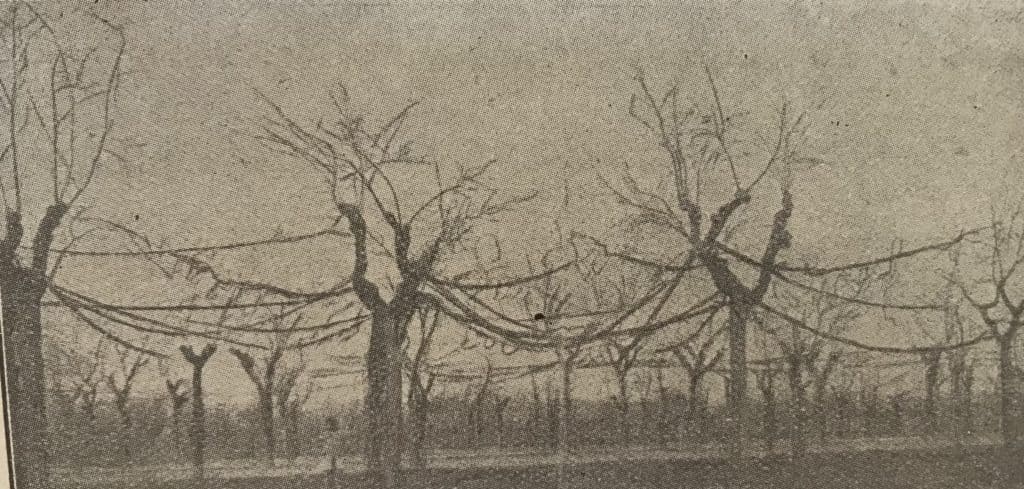
Married vines also appear in less relevant works of the late empire, such as the Opus Agricolturae of Palladius (4th century AD) and the Geoponica of the Byzantine Cassianus Bassus (6th century AD), which recommend them on moist soils. In the Middle Ages we find them in the work of Crescenzi (from Bologna), the only relevant medieval agricultural text of the European Middle Ages (1486).
In 1644, the Bolognese agronomist Vincenzo Tanara described the two main systems of married vines of his time, corresponding to the Roman systems. He calls them “piantata” (the arbustum gallicum) and “alberata” (the arbustum italicum), terms still used in modern Italian.
For all subsequent centuries, these two systems dominated viticulture in central and northern Italy, depending on the area. The alberata were plots of vines that climbed into individual trees, randomly placed in the field or with a regular arrangement. These plots, originating in central Etruria, remained traditional, especially in Tuscany (named “testucchio”), but also in Lazio and Umbria. The piantate was instead formed by rows in the border areas of fields or along the banks of ditches. They were more widespread in the north-central part of Etruria and in the areas of expansion to the south. Especially in the Po Valley and in Campania they remained traditional.


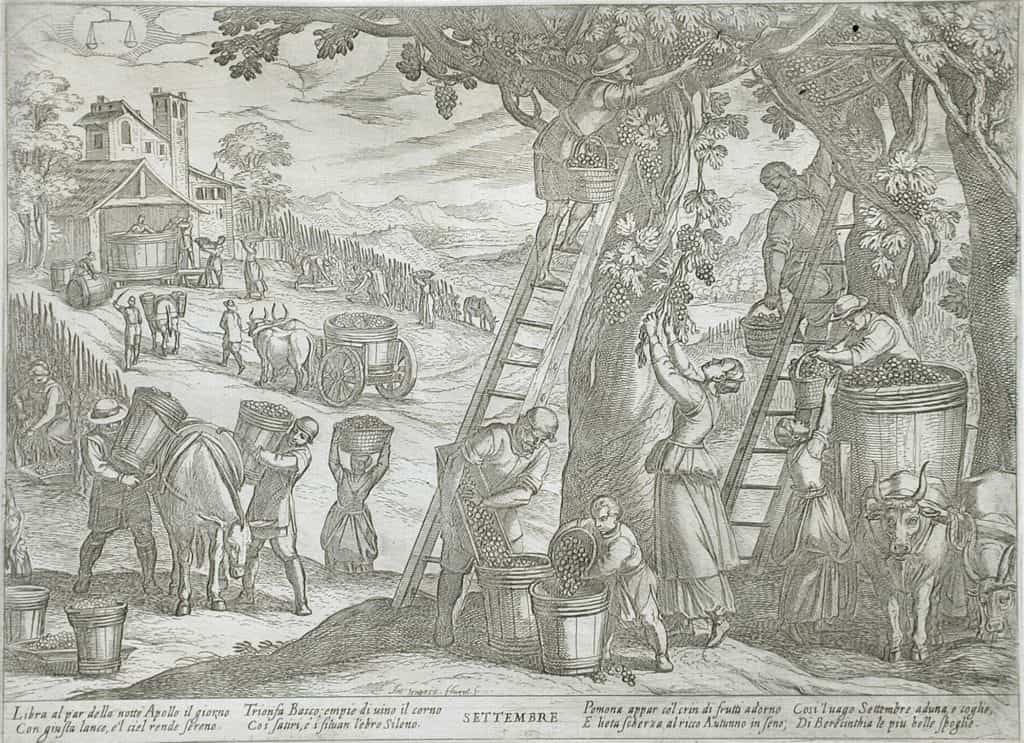
These landscapes also fascinated the foreign travelers of the eighteenth century who made their cultural journey in Italy, which was considered indispensable to the youth formation of the educated European class at the time. The landscapes with the married vines appear in many paintings of the period. They also appear in travel diaries, such as that of the French architect Jacques-Germain Soufflot in the mid-eighteenth century, who visited Paestum (Suitte Des Plans, Coupes, Profils, Elévations géometrales et perspectives de trois Temples antiques, tels qu’ils existoient en mil sept cent cinquante, dans la Bourgade de Pesto… Ils ont été mésurés et dessinés par J. G. Soufflot, Architecte du Roy. &c. in 1750. Et mis au jour par les soins de G. M. Dumont, en 1764, Chez Dumont, Paris, 1764), or by Goethe with his famous “Journey to Italy” (1813-1817).
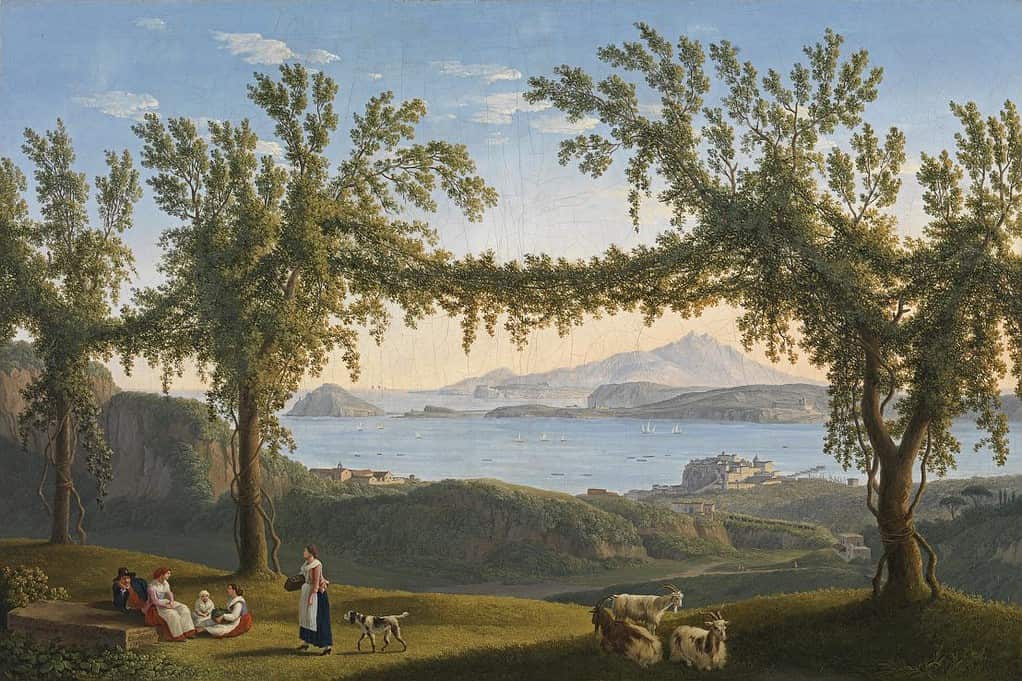
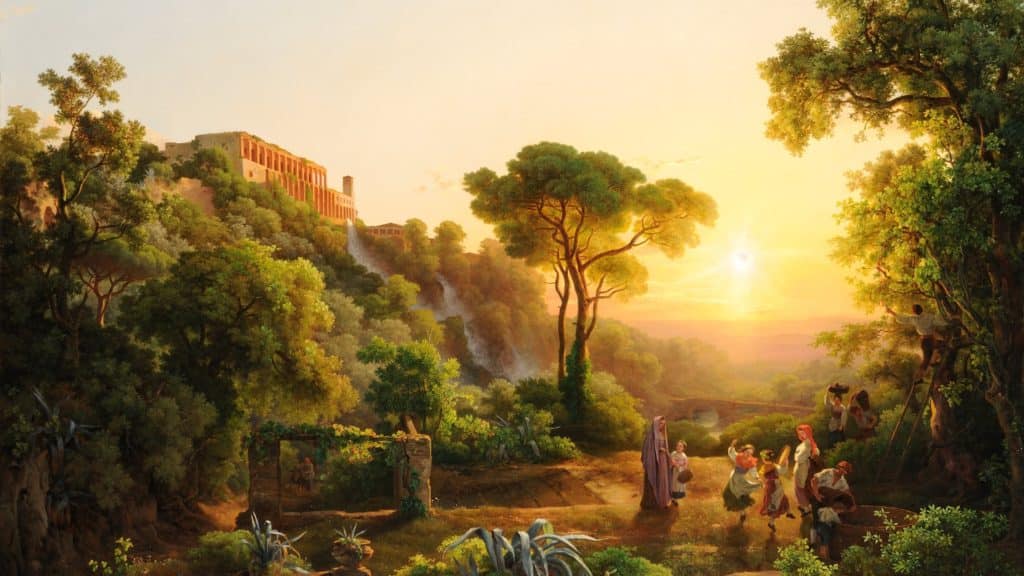
Gaius Valerius Catullus, for example, identifies the vine and the elm as woman and man in the “Bridal Song of Boys and Girls” (Carmina, poem 62, translation by E. T. Merrill):
“… As the vine which is widowed and grows in the naked field, never elevates itself, never allows a soft grape to ripen, but bent over under the weight of its tender body now and then touches its highest shoot with its root; this no farmer, no ox will cultivate: But if this same coincidence unites with the conjugal elm, many farmers, many oxen will cultivate it: so long as the virgin remains untouched, so long does she age, uncultivated; but if at the right time she obtains a suitable union, she is dearer to her husband and less of a burden to her father. “
In Ovid’s Metamorphosis (XIV, 623 et seq.), this metaphor appears in the love story of Vertumnus and Pomona. Vertumnus was a God of Etruscan origin, also remained in Roman religion. He was the God of transformations (verto, in Latin, basically means change): of the change of seasons but also of commerce. The God fell in love with Pomona, a very old Latin goddess of fruit growing, who was, however, unapproachable. He tried to reach her with various disguises, and he was successful when he took on the guise of an old woman. Then he tried to persuade her with various arguments, including the metaphor of the vine and the elm, to surrender to love:
“Across the way stood a specimen of an elm, covered with glistening bunches of grapes. After praising this and its accompanying vine, he (the “old woman”) said: “But if that tree were to stand there unharnessed, without its vine, one would look for it for no more than its leaves, and also the vine, which is connected to the elm and rests on it, would be on the ground, if it were not married to it and leaning on it. But you are not moved by the example of this tree, and you shun marriage, and do not want to be married. I wish you would!”
(A. S. Kline’s version)
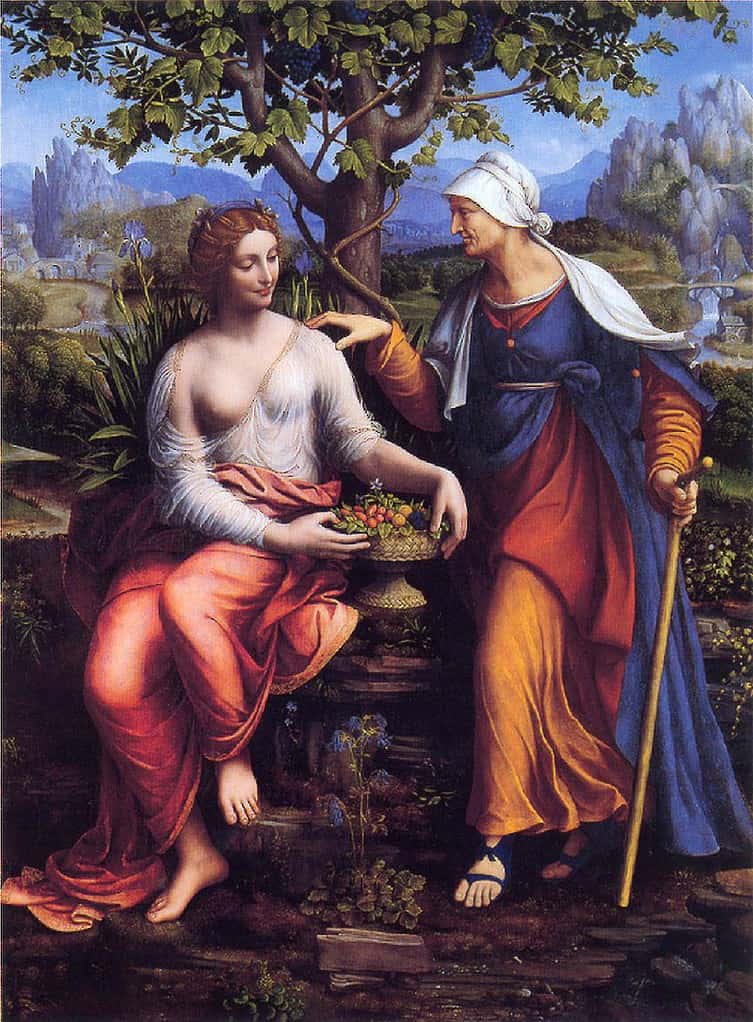
At the end of the speech, Vertumnus revealed himself. Pomona, struck by the words heard and the beauty of the God, surrendered to love.
This story had great success in the Renaissance and it will remain a very frequent artistic theme into the eighteenth century.
We also find this theme in Ovid (Amores, elegia XVI):
Ulmus amat vitem,
vitis non deserit ulmus;
Separor a domina
cur ego saepe mea?
“The elm loves the vine
The vine does not abandon the elm
Why have I been separated from my beloved so many times?
However, the theme of the vine married to the tree reached its greatest spread thanks to the Milanese jurist Giovanni Andrea Alciato or Alciati (1492-1550). He published a collection of allegories and symbols (represented by woodcuts), explaining their moral value with short texts in Latin. The title was “Emblemata,” published in Augsburg in 1531. It became an extraordinary success throughout Europe, with translations into Italian, French, Spanish, German and English. Alciato created a truly new literary genre, which continued to have great success in the following centuries, the emblematic book.
Alciato reported the married vine as the emblem of friendship and, in its purest form, of love, with the Latin title:
“Amicitia etiam post mortem durans”

This interpretation was influenced by an epigram by the Greek poet Antipater of Thessalonica (1st century BC), in which a withered plane tree tells how the vine, climbing on it, keeps it green. Alciato, who is from Lombardy, corrects the Greek’s mistake. The married vine was part of the agricultural landscapes of his native land and therefore he knew very well that the elm is the ideal spouse of the vine, and not the sycamore.
Thanks to Alciato and the success of the emblem book, the symbol of the vine married to the tree had a huge spread and appeared in many artistic representations, in poems and literary works from all over Europe. The married vine of Etruscan, Mediterranean origin thus became a decontextualized cultural symbol.
Thus, the Fleming Daniel Heinsius, in Emblemata amatoria (1620), instead of returning to Friendship, returned to bind it to Imperishable Love, as in classical times. He also returned to use the plane tree, as in the original Greek epigram. The married vine is the emblem of an eternal love that transcends death, with the wording
“Ni mesme la mort“,
not even death.

It also became the logo of the Elzevier, publishers of Leiden (Holland) from 1580. Today’s publisher, Elsevier (re-established in the nineteenth century), is the world’s largest medical and scientific publisher. Their symbol remains the original, a life married to a tree, with the meaning of the alliance between scholarship and literature.

From the nineteenth century onward, viticulture became a science and many agricultural treaties flourished, describing in detail the traditional Italian systems. For this section, I refer to the works of two eminent scholars of the nineteenth and twentieth centuries, Prof. Ottavio Ottavi and Prof. Domizio Cavazza.
Italian viticulture of the time, in the center-north, had remained based on that of ancient Rome, with the arbustum italicum (alberata) and of the arbustum gallicum (piantata). However, these two archetypes had given rise to a myriad of different systems, which (the same scholars admit) were difficult to enumerate in all possible variations. Moreover, there was much confusion in terms at this point. The term “alberata” was often used to denote one system or the other.
Elm, maple and poplar were especially still used. Now we can also understand why.
The ideal, as a living teacher, is a plant with a small root system and foliage, as these should not hinder the development of the vine. The perfect tree is the maple (Acer campestris), the favorite for vines since the ancient Etruscans. It grows slowly, has few roots that go deep and does not interfere with those of the vines. Pruning can easily sculpt its small foliage. It also adapts well to poor and shallow soils.
The elm (Ulmus campestris) remains the most widely used tree in the north. It has a strong radical expansion but is very long-lived, producing excellent forage (leaves) and branches and wood. It adapts better to the fertile and moist soils of the Po Valley.
The poplar (Populus nigra) was used for its rapid growth and because it produces fodder and wood. It is not so suitable for grapevine because it has an extensive root system and too dense foliage.
The mulberry (Morus alba) was used especially in Veneto, although it was not suitable. He competes too much with the vine. However, it is suitable for merging two businesses: grapes and silkworm farming. However, the introduction of copper treatments in the late nineteenth century (which kills the insect) made this coexistence very difficult.
In addition, to a lesser extent, these trees were also used: the willow, manna ash, ash, dogwood, linden, hornbeam, oak, cherry, olive tree, walnut and fig tree.
The simplest system, the old arbustum italicum, was called testucchio. It was especially widespread in Tuscany, but also in the Marches and Latium, with a slightly different method of planting and pruning. Maple trees, called oppi or loppi in Tuscany (acero, in Italian), were mostly used. Under the testucchi, vintners could also grow low vines, by resting them on canes to form a full row. There were similar solutions in the Caserta area, but with tall vines.
In Abruzzo, the vines were intertwined into a large horizontal square called capanne or capannoni.
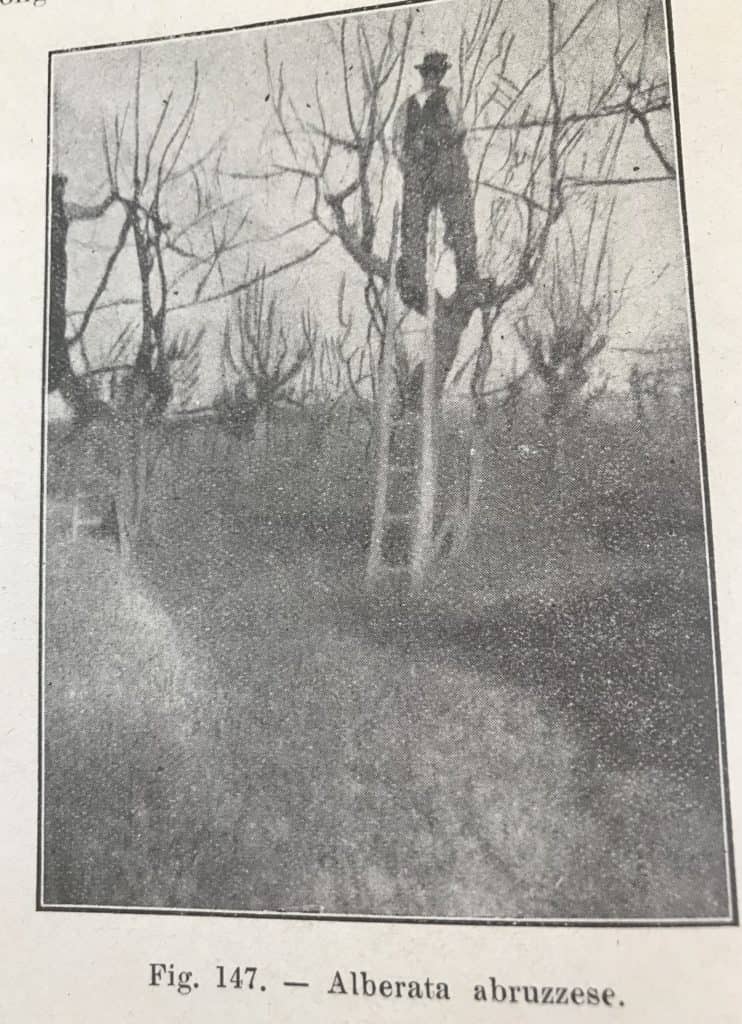
In the region of Aversa (near Naples), Asprinio grapes grown on poplars reached heights of up to 20 meters. Note, in the photo, the size of the man on the tree. In the middle row, the vintners grow other species such as hemp, corn, potatoes and various grains.
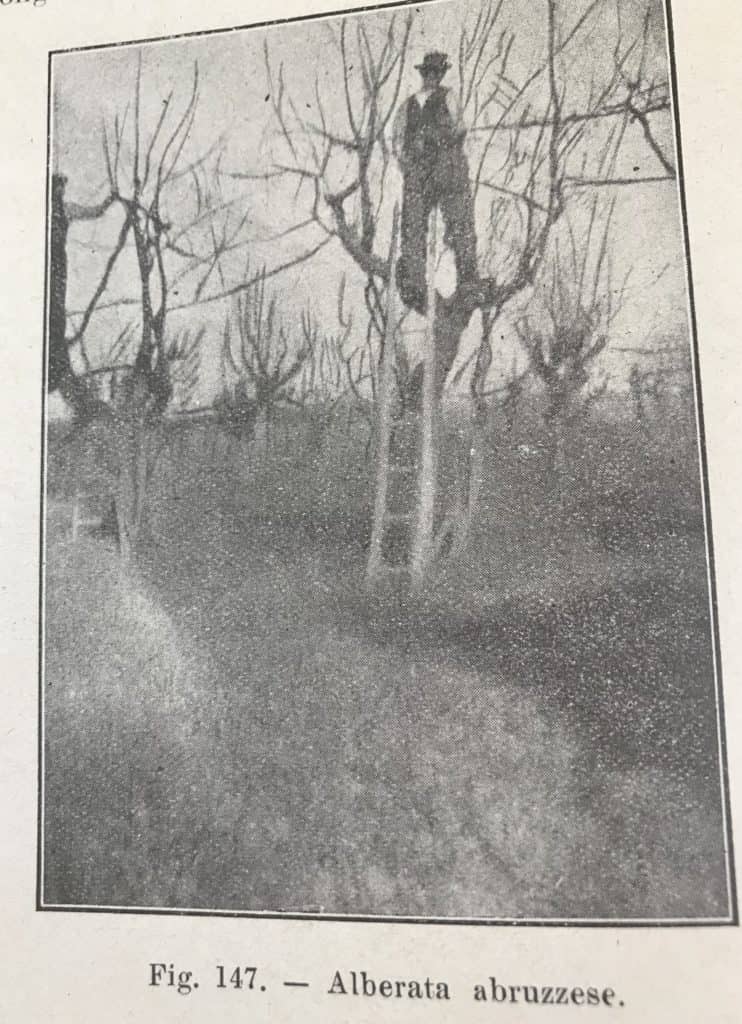
The “Chianti system” was based on maple trees, whose branches were pruned horizontally and attached to those of their neighbors, creating a kind of continuous espalier on which the vine could climb.
The “pendulum system” (or “tralciaia” or “pinzana”) was typical of the regions of Pisa (Tuscany), Caserta, Naples and the Emilia. The garlands were formed by very long intertwined vines. Sometimes they had to be held up with sticks or separated by a crossbar.
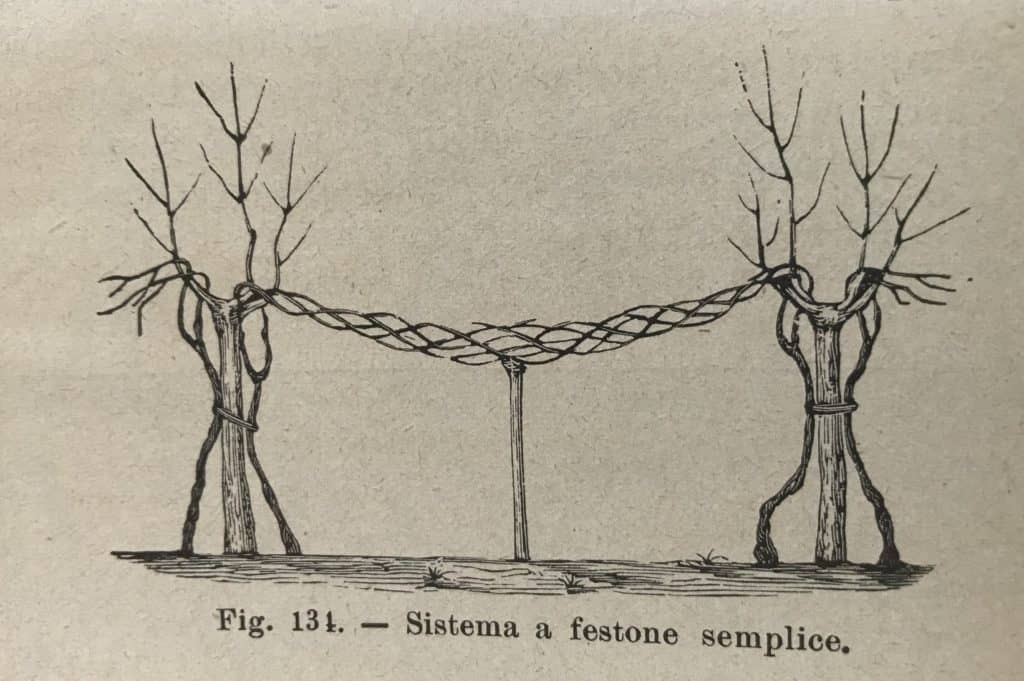
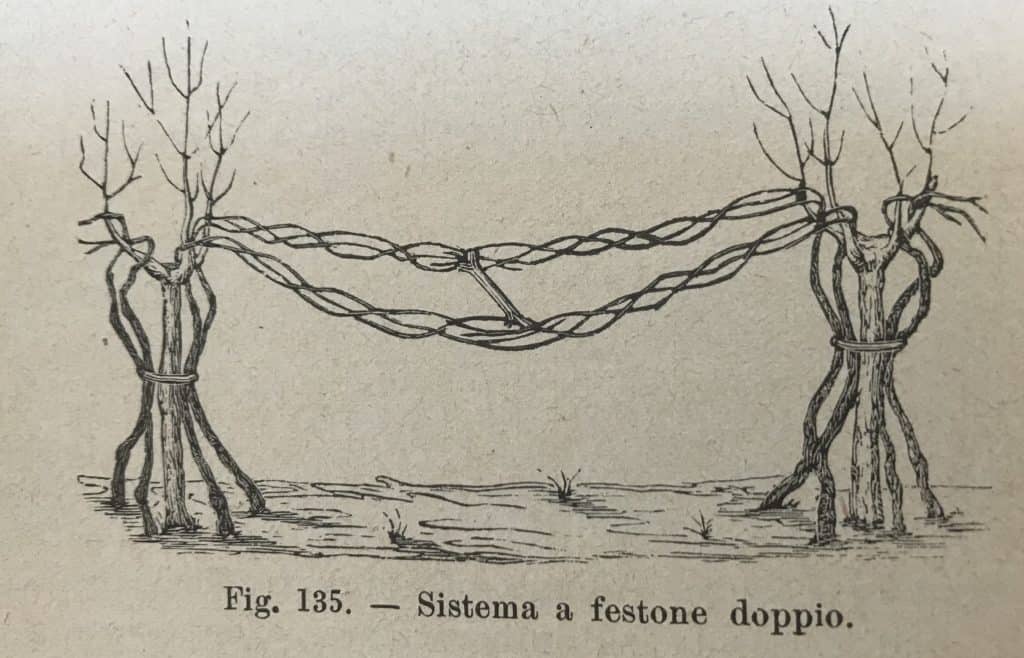
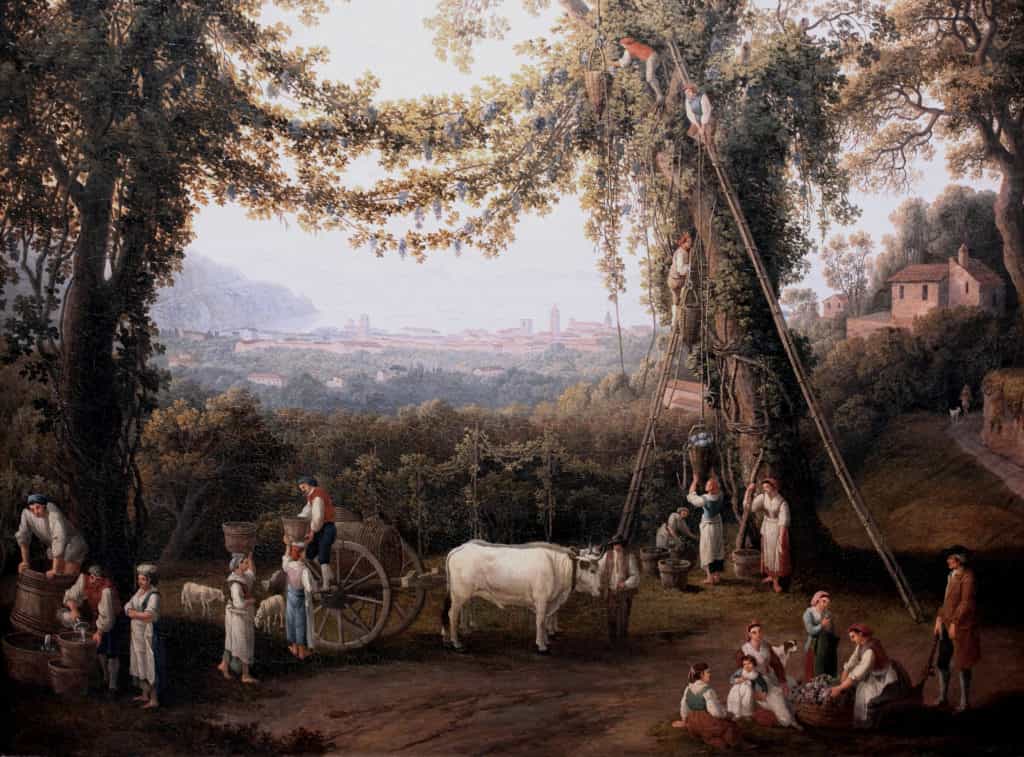
In Emilia the elm was mainly used, in Romagna the maple, both much lower. In the region of Ferrara, the vines stood very high on walnut trees. In these regions, the rows of “married vines” were often at the edge of fields and along ditches.

The “Istrian system” was based on low-growing maples or ash trees, as stumps, from which numerous branches spread out, joined together to form a circle at a certain height. The vines reached up to the circle, then spread out and joined the neighboring trees. This system was used for local varieties such as Terrano, Isolana, Nera tenera and Crevatizza. Prof. Ottavi says this system was already disappearing at the time.
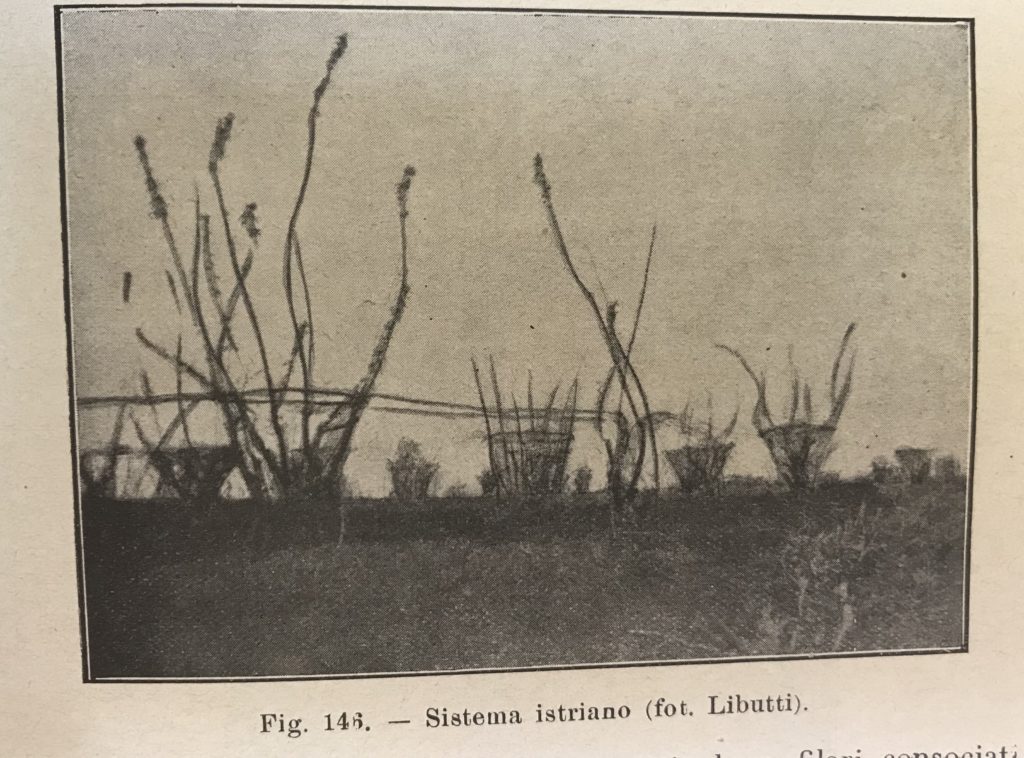
In the nineteenth-twentieth century, some new blending forms emerged from the more traditional ones, with wires and poles along with trees, in an attempt to modernize this type of vine raising system. One example was the “ray system” or Bellussi (after the name of its inventors). It was especially widespread in Veneto. The ray systems had numerous variations.
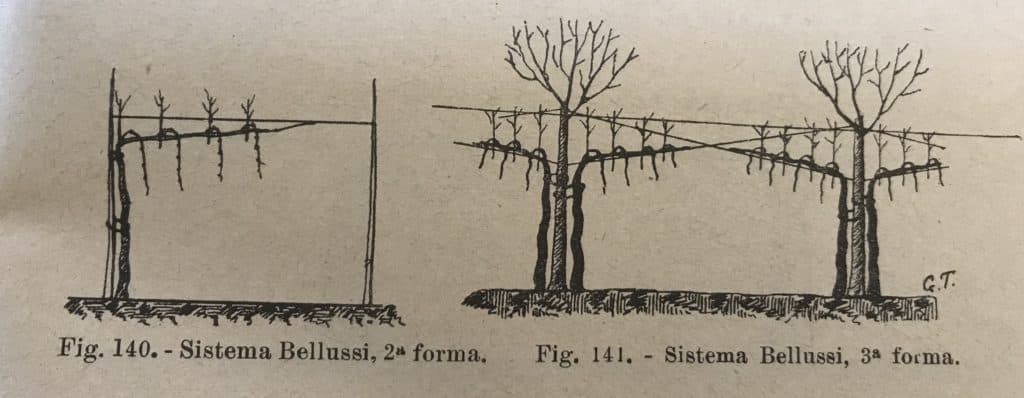

The mixed pergolas consisted of trees with wooden stands and iron wires. They were in the Tivoli area, in Piedmont and in Emilia.
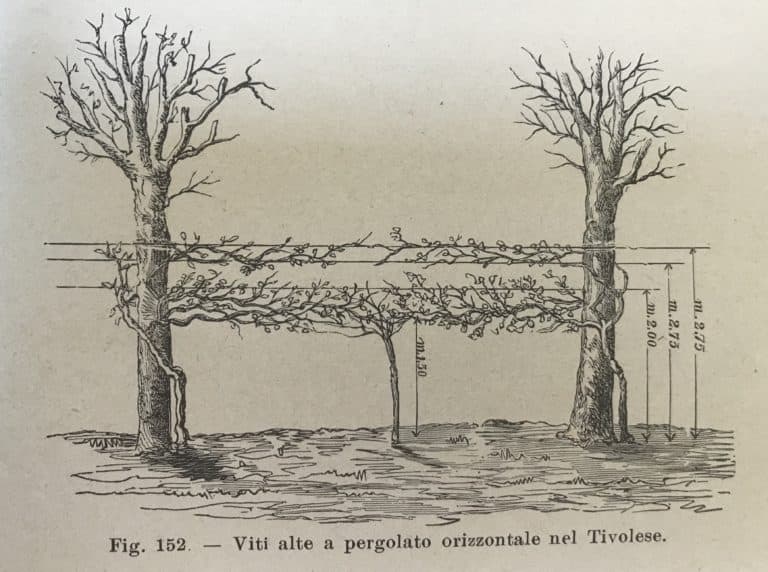
Anyway, in the twentieth century, this old culture disappeared.
Starting in 1920, a fungus from Asia decimated elms (Dutch elm disease, DED, “grafiosi” in Italian).
In the 1920s, Prof. Cavazza explained that the gradual disappearance of the “married vines” was mainly due to changed technical and economic conditions. He lists the disadvantages of this system over the “dead” teacher (a stick): it takes longer to achieve normal production, the trees shade the vine, the grapes ripen later, there is more need for fertilizer (both for the vines and the trees), more effort and cost in pruning and all other work (from treatments to harvest).
Yet for a long time he resisted even the indisputable advantages enumerated by Cavazza himself, such as the great longevity of the vineyard. In addition, the garden gardens also provide useful products for the farm, such as fodder for the animals and faggots. The trees partially protect the vines from frost and hail. Under the trees, the wine growers can grow other crops… It is easy to understand that these advantages, however, belong to a versatile agriculture, to an old rural world that could no longer exist.
In fact, Italian viticulture, especially after World War II, underwent a profound transformation. Modern production required highly specialized viticulture. In this new world, there was no longer a place for the “married vine,” which had survived for over three thousand years.
If you want to see an Etruscan vineyard, you can come to Guado al Melo: we have created it with local wild vines. Alternatively, you can still find one of the above systems in Aversa zone or in some small estates of Tuscany and Emilia Romagna.
Italy has certainly sacrificed much of its rural culture to modernity. The most important thing is not to lose the memory of it, because it is part of our history. That is why there is a “married vine” on the label of our wine Atis (Bolgheri DOC Superiore).





